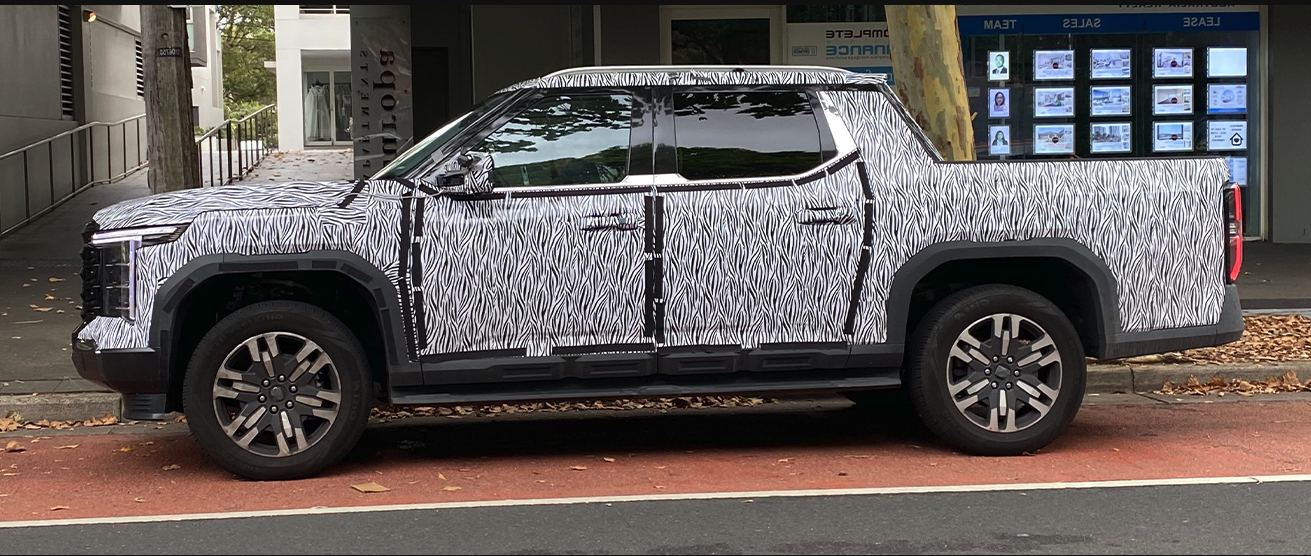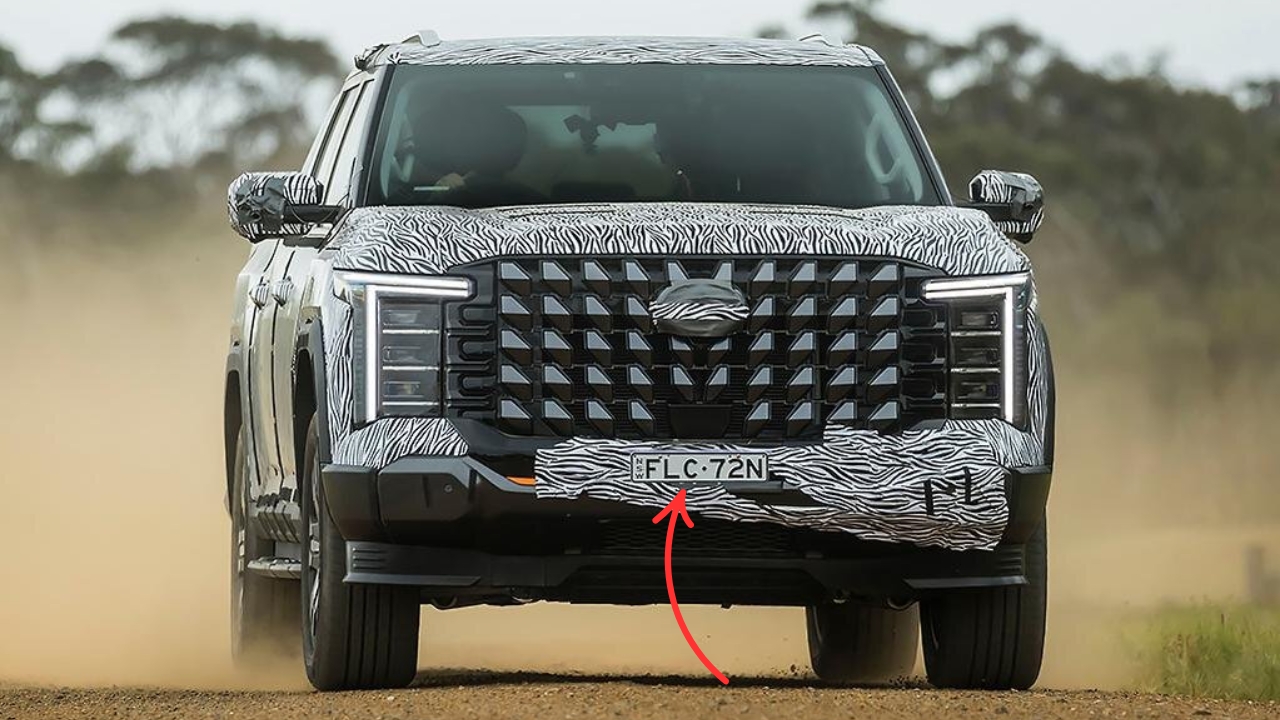2025 LDV eTerron 9 Electric Ute :The future of Australian electric utes has literally hit the streets. The 2025 LDV eTerron 9 has been spotted in all of its boxy glory in Sydney just weeks before its official launch in Australia.
Car enthusiasts and industry watchers got their first real glimpse of this game-changing electric vehicle during recent testing phases. The timing couldn’t be more perfect as Australia prepares for a massive shift toward electrified commercial vehicles.
Real-World Testing Reveals Impressive Details
The electric ute was spied in the Royal National Park south of Sydney by a member of the BYD Shark Owners Club Australia group on Facebook. This wasn’t just a random sighting though. The vehicle carries serious credentials that suggest extensive validation testing is underway.
From its New South Wales number plate (FLC-72S) that it’s one of two Terron 9 vehicles pictured in a press release to announce its commencement late last year. This particular registration number tells us exactly what LDV engineers have been up to across the continent.
The testing program started back in November 2024 and covers much more than just basic road trials. Engineers have been pushing this electric ute through its paces across three different states to ensure it meets Australian driving conditions.
Advanced Technology Undergoes Australian Validation
LDV engineers have been testing the Terron 9’s traffic sign recognition, lane-keep assist and other electronic driver aid systems – often a source of annoyance for drivers when programmed poorly – on main and backroads in New South Wales, Victoria and Queensland in a bid to better calibrate the ute for local conditions. These systems require precise calibration for Australian road conditions, which differ significantly from overseas markets.
The validation process involves more than just safety technology. The other (FLC-72N) was a camouflaged Terron 9 that we understand has since undergone local validation work on its advanced driver assistance systems (ADAS) including lane-keeping and speed sign recognition functions, as well as its multimedia and battery charging systems.
This comprehensive approach shows LDV’s commitment to delivering a properly engineered vehicle. Rather than simply importing an overseas model, they’re investing time and resources to get everything right for Australian conditions.
Specifications That Challenge the Competition
The eTerron 9 brings serious specifications to the table. Both single-motor rear-wheel drive and dual-motor four-wheel drive layouts of the electric eTerron 9 have been approved for Australian roads, developing 200kW and 325kW respectively, which is significantly more than the 130kW rear-drive-only eT60.
That 325kW output from the dual-motor setup puts this electric ute in serious performance territory. For comparison, most diesel utes struggle to achieve half that power output, making this a genuine performance upgrade over traditional options.
The eTerron 9’s electric motors are fed by a 102kWh lithium iron phosphate (LFP) battery pack, which can provide up to 430km of claimed driving range based on the WLTP test cycle in the dual-motor variant. This range figure addresses one of the biggest concerns potential buyers have about electric commercial vehicles.
Towing Capacity Matches Diesel Rivals
Government certification documents also show it will offer the same 3500kg braked towing capacity as its diesel counterpart. This towing capability puts the eTerron 9 on equal footing with established competitors like the Ford Ranger and Toyota Hilux.
Commercial users who rely on substantial towing capacity won’t need to compromise when switching to electric power. The combination of serious towing ability and zero local emissions makes this particularly attractive for businesses operating in urban environments.
Physical Presence Commands Attention
The Terron 9 measures a substantial 5500mm long, 1997mm wide and 1860mm tall on a 3300mm wheelbase, and has 220mm of ground clearance, making it 105mm longer, 97mm wider and 41mm taller than the T60 Max Plus on a 125mm longer wheelbase. These dimensions clearly position this as a full-size commercial vehicle rather than a compromise solution.
The increased size translates to better interior space and improved payload capacity. Users won’t feel like they’re sacrificing practicality for environmental benefits, which has been a common concern with earlier electric commercial vehicles.
The battery-powered eTerron 9, meantime, features a different grille and headlight treatment but shares identical dimensions to its turbo-diesel sibling, ensuring consistent capability across the range.
Modern Convenience Features
It also features vehicle-to-load (V2L) capability, allowing owners to power external appliances and tools, with overseas examples featuring several 2.2kW sockets throughout the vehicle, plus an external 6.6kW connection. This vehicle-to-load technology transforms the ute into a mobile power station.
Tradies and outdoor enthusiasts will appreciate the ability to run power tools, camping equipment, or emergency lighting directly from the vehicle. The 6.6kW external connection provides enough power for substantial equipment or even emergency home backup during outages.
Market Timing and Competition Context
The eTerron 9’s mid-2025 arrival will coincide with a flurry of electric or plug-in hybrid (PHEV) utes going on sale or having already launched in Australia. The timing puts LDV in direct competition with several established manufacturers entering the electric ute space.
The BYD Shark 6 PHEV is soon rolling out to customers, the Ford Ranger PHEV is due in early 2025, and the GWM Cannon Alpha PHEV is expected around March or April. This competitive landscape means buyers will have multiple options when shopping for electrified utes.
However, the eTerron 9 stands out as a pure electric option rather than a hybrid. This approach appeals to buyers seeking complete elimination of fossil fuel dependence rather than just reduced consumption.
Learning from Previous Mistakes
Since going on sale in late 2022, approximately 100 eT60s have been sold – mainly to fleets and businesses targeting zero tailpipe emissions – with its launch price of $92,990 before on-road costs more than double that of the turbo-diesel T60. The previous eT60 model struggled with limited sales due to various shortcomings.
“This is a completely different vehicle, inside and out,” said Mr Chinnappa. “We are proud that the LDV eT60 was the first electric ute in Australian showrooms, but we are also proud to demonstrate just how far electric ute technology has progressed with this all-new model.” This statement acknowledges past limitations while emphasizing significant improvements.
The ground-up design approach means the eTerron 9 avoids the compromises inherent in converting existing diesel platforms. Every component has been optimized for electric operation from the beginning.
Local Testing Demonstrates Commitment

“The purpose of this validation test is to ensure the new-generation LDV Terron ute series is ready for Australian driving conditions,” said Dinesh Chinnappa, LDV Australia general manager. This local validation work represents a substantial investment in getting the product right.
“The arrival of these vehicles for final validation testing shows the factory recognises the importance of the Australian market,” said Chinnappa. The Australian market clearly represents a strategic priority for LDV rather than just an afterthought.
Most international manufacturers simply import vehicles with minimal local adaptation. The extensive testing program shows LDV’s understanding that Australian conditions require specific engineering solutions.
Target Market Recognition
“Certain segments of the ute market are not only ready for an electric ute, they’ve been pleading for one,” he says, pointing to “fleets and mining companies who want a factory-built, turn-key solution straight off the showroom floor, rather than a diesel vehicle that has been converted to electric power.” This recognition of specific market demand indicates careful market research.
Fleet operators and mining companies face increasing pressure to reduce emissions while maintaining operational capability. The eTerron 9 directly addresses these requirements without forcing compromises on practical performance.
Launch Timeline and Market Expectations
Government approval documents first reported by CarExpert earlier this month uncovered the turbo-diesel Terron 9 and its electric eTerron 9 sibling, with LDV’s website confirming at the time the latter ute was due during the first quarter of 2025 (January to March). That launch timing has now been pushed back to the second quarter (April to June), allowing more time for thorough validation.
The delayed launch actually demonstrates responsible product development. Rather than rushing to market with potential issues, LDV is taking time to ensure proper calibration and testing completion.
Pricing and specifications for the LDV Terron 9 and eTerron 9 will be announced closer to each model’s Australian arrival. The pricing strategy will largely determine market reception, especially given the competitive landscape developing in the electric ute segment.
Industry Impact Expectations
The eTerron 9 represents more than just another model launch. It signals the maturation of electric ute technology from experimental offerings to serious commercial vehicles capable of replacing diesel equivalents.
Australian businesses have been waiting for electric utes that don’t require significant operational compromises. The combination of substantial range, serious towing capacity, and proven reliability could accelerate commercial adoption of electric vehicles.
Success of the eTerron 9 will likely influence other manufacturers to accelerate their own electric ute development programs. The Australian market could become a testing ground for the next generation of commercial electric vehicles.
Technical Innovation Highlights
The 102kWh battery capacity represents current state-of-the-art technology in the commercial vehicle space. It has a 102kWh LFP battery claimed to provide about 430km of WLTP range. The use of LFP chemistry provides better longevity and thermal stability compared to alternative battery technologies.
Lithium iron phosphate batteries also offer improved safety characteristics and longer cycle life. For commercial users, this translates to lower total cost of ownership over the vehicle’s operational lifespan.
The dual-motor configuration provides genuine all-wheel drive capability without the mechanical complexity of traditional transfer cases and differentials. This approach offers instant torque distribution and improved traction control.
Charging and Infrastructure Considerations
While specific charging capabilities haven’t been fully detailed, the large battery capacity suggests compatibility with high-power DC charging infrastructure. This will be crucial for commercial users who need to minimize downtime during operations.
The vehicle-to-load capability partially addresses range anxiety by providing alternative use for stored energy. Rather than simply depleting the battery through driving, users can extract value by powering equipment or providing emergency power.
Australian charging infrastructure continues expanding rapidly, making long-distance operation increasingly viable. The 430km range should handle most daily commercial requirements without requiring mid-day charging stops.
Market Position and Strategic Implications
The diesel Terron 9 will be sold alongside – and positioned above – the existing LDV T60 lineup. This positioning strategy allows LDV to address multiple market segments while maintaining their established customer base.
The three-tier approach with T60, Terron 9 diesel, and eTerron 9 electric provides clear upgrade paths for existing customers. Businesses can transition gradually from conventional to hybrid to fully electric as their comfort level and requirements evolve.
LDV’s strategy appears focused on long-term market development rather than short-term sales maximization. This approach should build customer loyalty and establish the brand as a serious player in the evolving commercial vehicle market.
Frequently Asked Questions
When will the LDV eTerron 9 be available for purchase in Australia? The LDV eTerron 9 is expected to launch in the second quarter of 2025, between April and June.
What is the towing capacity of the electric eTerron 9? The eTerron 9 offers a 3500kg braked towing capacity, matching its diesel counterpart and competing directly with traditional utes.
How far can the eTerron 9 travel on a single charge? The dual-motor variant provides up to 430km of WLTP-rated range from its 102kWh lithium iron phosphate battery pack.

